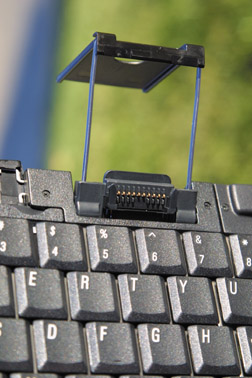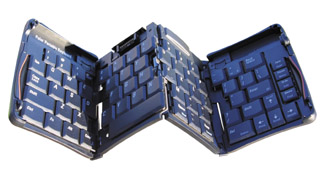Keyboards are keyboards many would say--but that's not the case with the Stowaway Keyboard. Let's cut right to the point-this keyboard folds up into something that can fit into your pocket. If you had any doubts, let me reassure you, I've been able to tuck this into my coat pocket, jacket pocket-even the pockets on my pants (but I won't usually do that since I don't want to end up sitting on it).
The idea of a foldable keyboard predates Think Outside and handheld computing altogether. IBM pioneered this sort of keyboard with their 'Butterfly' laptops. Their keyboards didn't fold up quite as neatly as the Stowaway does; their design allowed the left and right sections (out of three) to separate and slide under the rest of the keyboard when the laptop was closed. When you opened the Butterfly the keyboard opened up to give you a full-size keyboard you could work on. Everyone talked about how fantastic this was-but then IBM never used the Butterfly keyboard again, and laptops started moving toward larger displays that made this sort of keyboard unnecessary.

Think Outside has now brought this concept a generation forward for the users of handheld computers. This time around it's a perfect fit. We're not likely to see the desire for physically larger screens in this form factor, so a small keyboard solution is perfect this time around.
The Stowaway has a full size QWERTY keyboard with a pretty standard layout. All the letters, numbers, symbols, Enter, and so on are exactly where you're used to finding them. Touch typists like myself will have no problems with this keyboard.
As you can see from the pictures there are some accommodations made, however. The arrow keys are shifted to the left far enough to move most of them under the Enter key which required shortening the Shift key on the right side. The Delete key was also moved and placed in front of the arrow keys. The Tilde key is in this area as well, which is about the most dramatic move of all. Fortunately it's one of the least used keys so it's not a big issue-although it looks like there would've been space for it in its usual position. Ctrl, Alt, and some new keys are in the same places where you would find them and Windows 95/98 specific keys on other keyboards. There are no function keys, as such, but there are four Palm-specific keys on the right to access the same applications the four buttons on the Palm would access. The redesign makes sense and requires almost no relearning for typists.
The physical size of the keyboard when closed is only slightly larger than a Palm-mostly just a little thicker. Unfolded it is about four-fifths of the size of a Windows keyboard. For you techies, the actual dimensions in the open position are 13.8" long, by 5.1" deep, by .44" tall. Folded it is only 3.6" by 5.1" by .8". The keys are similar to laptop keys and have a good deal of travel to them when pressed. Overall the device is exceptionally light in weight, yet it feels strong and durable.

Using the Stowaway is easy. You simply slide the lock down and unfold the four sections flat. Then you slide the outer two sections inward using the handles marked in red. There are spring-loaded cams along the top to be sure you get everything in the proper position when opening or closing. Slide out the supporting brace that helps hold the Palm up at the proper angle, and tilt the whole thing up, flipping the black plastic support out. That's it! Reverse the process to put it away in its nice neoprene case.
Because its folding mechanism does not lock open, it cannot be used on your lap, but other than that there are no significant disadvantages whatsoever. It simply works, and works well. It fills the need that some handheld computer owners have for a keyboard and does it in an elegant way. Absolutely fantastic! Available for all Palm, TRGpro, and IBM models at www.palm.com, and for Handspring Visors at www.targus.com. US$99
-Kermit Woodall
Back to Palm Section

